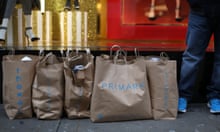Do expensive clothes come with a guarantee of ethics? If you pay more for clothing, do workers on assembly lines and in cotton fields automatically get paid more?
Cheap retailers such as Primark, Tesco and Asda are generally held up as the villains of the industry: accused of driving wages and working conditions down through their desire to sell clothes at extraordinarily cheap prices. Buying expensive clothes is often suggested as an ethical option, with the idea being that designer brands somehow use their profit margins to benefit their workforce. However, a high price tag is no guarantee of ethical practices.
Numerous high-end brands including Prada, Hugo Boss and Dolce and Gabbana have been highlighted in a recent Clean Clothes Campaign report on conditions in the “Euro-Mediterranean textile cluster” – the former Soviet countries of eastern Europe plus Turkey. The rise of this region as a fashion industry hub has been aided by its “Made in Europe” brand – a concept that purports to be a guarantee of standards above and beyond those of “Made in Asia”.
According to the report, Germany and Italy are the biggest destinations for garments from this European hub and many customers are from the luxury sector. So while workers in Moldova produce clothes for Primark and Tesco, they also sew for Versace, Dolce and Gabbana, Armani, and Max Mara.
One striking finding from the report is that the gap between legal minimum wages (the legal minimum a person can be paid) and minimum estimates for living wages (the minimum pay rate needed for a person to lead a decent life) tended to be “even larger in Europe’s cheap labour countries than in Asia”.
In Croatia for example, the report says suppliers for Benetton and Hugo Boss pay one-third of what would constitute a minimum living wage. A spokesperson from Hugo Boss states that it “obligates its suppliers to comply with the applicable minimum wage legislation” and that “wage negotiations are the exclusive domain of the supplier, its workforce and other parties within their countries, some of which are accorded roles by national legislation,” though it is “open to every form of constructive dialogue”.
It is low minimum wages that draw corporations to the global south. Burberry’s decision to close factories in Britain in 2007 and relocate manufacturing to China was driven by cost based analysis – it wanted to make £1.5m a year more in profit. Profit depends on companies maximising the difference between a garment’s sale price and its production cost. High-end retailers and the luxury sector can appear to exist outside of this system – shielded by ideas like craftsmanship and design, but behind the gloss is the same dirt. The same factories and the same working conditions.
A spokesperson from the Clean Clothes Campaign states that “none of the premium brands have responded to the report.” Hugo Boss received a pre-release copy of Stitched Up and while it has spoken with the Clean Clothes Campaign is hasn’t made a specific statement on the Stitched Up findings.
Rewinding back through the supply chain, filmmaker Leah Borromeo has documented India’s cotton fields for Dirty White Gold: “If you want a purely ethical line you also have to go beyond this idea that your clothes are made in a sweatshop, that’s not where they are made, that is where they are processed,” she explains. “You have to look at who made the thread for that fabric and who supplied the cotton for that thread. At the base of it is the farmer.” Borromeo points out that fields aren’t divided between expensive brands and cheap brands, instead the same farmers and labourers are at the behest of the market.
Nor are poverty wages by high-end brands just an overseas issue. Amy Hulme, programme manager at the Living Wage Foundation, points out that there are no retailers – either high street or high end – registered as paying the living wage to shop staff in Britain: “We hope that the retail industry will strive to do better. They employ a very large amount of people in this country and if they did implement the living wage it would lift a huge number of people out of working poverty and allow them to have some financial stability.”
Hulme believes paying a living wage has highly positive benefits: “Every argument for being a sustainable company can be applied to the living wage. You get more from happier staff who feel like you value them. Companies we have already accredited say staff turnover is lower and they save money on training.”
With high-end brands, further insult is added to the injury of low wages, as workers sew and sell items that they have no chance of ever affording. Luxury it seems has more respect for their merchandise than for people.
Read more like this:
- How to achieve fair wages in the fashion industry - we ask the experts
- To respect human rights, fashion needs business, unions and governments
- Advertisement feature: H&M’s roadmap to a fair living wage in the textile industry
The sustainable fashion hub is funded by H&M. All content is editorially independent except for pieces labelled advertisement feature. Find out more here.
Join the community of sustainability professionals and experts. Become a GSB member to get more stories like this direct to your inbox







Comments (…)
Sign in or create your Guardian account to join the discussion